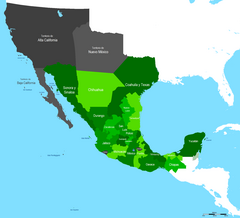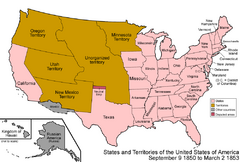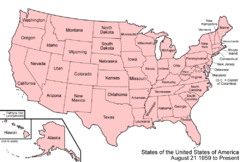Biology:Territorial evolution of California
thumb|240px|Spanish period: An enlargeable map of the United States after the Treaty of Paris in 1783.
The following timeline traces the territorial evolution of California, the California admitted to the United States , including the process of removing Indigenous Peoples from their native lands, or restricting them to reservations.
Timeline[lower-alpha 1]
Indigenous & territorial claims prior to 1768
- Indigenous peoples of California, see Before 1768 map
- Broad early European edicts and treaties that unknowingly included the land that would later become California
- Inter caetera papal bull issued by Pope Alexander VI, 1493
- Treaty of Tordesillas, 1494
- Vasco Núñez de Balboa claims South Sea (Pacific Ocean) and all adjoining lands for Spain, 1513
- Treaty of Saragossa, 1529
- Early European claims on California soil
 Rio de Buen Guia (Colorado River) claim made by Hernando de Alarcon on behalf of Spain , September 1540
Rio de Buen Guia (Colorado River) claim made by Hernando de Alarcon on behalf of Spain , September 1540 Rio de Tizon Delta (Imperial Valley) claim made by Melchor Diaz on behalf of Spain , December 1540.
Rio de Tizon Delta (Imperial Valley) claim made by Melchor Diaz on behalf of Spain , December 1540. San Miguel (San Diego) claim made by Juan Rodríguez Cabrillo on behalf of Spain , 1542
San Miguel (San Diego) claim made by Juan Rodríguez Cabrillo on behalf of Spain , 1542 New Albion (Point Reyes) claim made by Sir Francis Drake on behalf of England , 1579
New Albion (Point Reyes) claim made by Sir Francis Drake on behalf of England , 1579 Rio Colorado (Colorado River) claim made by Juan de Onate on behalf of Spain , January 1605
Rio Colorado (Colorado River) claim made by Juan de Onate on behalf of Spain , January 1605 Rio Colorado (Yuma Crossing) claim made by Eusebio Kino on behalf of Spain , 1701
Rio Colorado (Yuma Crossing) claim made by Eusebio Kino on behalf of Spain , 1701
Spanish period (1768–1821)
- Template:Country data Spanish Empire Las Californias claimed by Spain under the governance of the Viceroyalty of New Spain, 1768–1804
- Portolá-Crespí Expedition 1769–1771, Discovers Most of California Coast from San Diego to San Francisco, Claims Land for Spain.
- Pedro Fages 1st Expedition 1770 Discovers East San Francisco Bay, Salinas Valley & Santa Clara Valley.
- Pedro Fages 2nd Expedition 1772 Discovers San Joaquin Valley, Old Tejon Pass, & Antelope Valley.
- Juan Bautista de Anza Expeditions 1774; 1775 Brings settlers to California to settle Coastal Areas in the name of Spain.
- Juan de Ayala Naval Expedition 1775. First to sail past Golden Gate and discover San Francisco Bay.
- Francisco Garcés Expedition 1776 Discovers Mojave Desert, Cajon Pass, & San Bernardino Valley. Explores Old Tejon Pass, & Tulare Lake Basin.
- Pedro Fages Expedition in 1781 was Sent to put down Yuma Indian rebellion in the Colorado River but lost control of the area to Indians, essentially closing the main overroute trail connection from Alta California to Mexico.
- Hermenegildo Sal Expedition 1796 Explores San Joaquin Valley around the current Stockton area
- Spanish missions in California, 1769–1833
- Relocation of Mission Indians, 1769–1834
- Spanish rancho land grants, 1769–1821
- Peace of Paris, 1783
- Spanish missions in California, 1769–1833
- Alta California Province established, 1804–1821
- Friar Juan Martin Expedition 1804, Explores the southern Central Valley Region for new mission sites. Visits Salinan Tco'alam Village which he names Cholam Village
- Friar Juan Martin Expedition 1805, Explores Lake Tulare Region for new mission sites. Visits Yokut Wowal Village which he names Bubal Village
- José María de Zalvidea Expedition 1806, Scouting for new Mission sites from Santa Barbara Mission to San Gabriel Mission.
- Lt. Francisco María Ruiz Expedition 1806, Explores route from Sonora to Central Valley via Old Tejon Pass, Discovers Cãnada de las Uvas (Tejon Pass) which opens a new route to Mission San Fernando.
- Gabriel Moraga Expedition 1806, Discovers Sierra Nevada Foothills and it's Rivers. Explores Tulare region, and Kern River Wilderness.
- Friar Francisco Dumetz Expedition 1810, Discovers San Bernardino Valley.
- Mexican War of Independence, 1808–1821
Mexican period (1821–1848)
- Alta California Province transferred to Mexico after Treaty of Córdoba, 1821–1824
 First Mexican Empire, 1821–1823
First Mexican Empire, 1821–1823- Provisional Government of Mexico, 1823–1824
- Captain José Romero Expedition December 1823– January 1824 Discovers Valle de la Palma de Dios (Coachella Valley) exploring a route through the Sonoran Desert to Tucson Pueblo. attempting to establish the Landroute connection between California and Mexico abandoned since 1781.
 First Mexican Republic, 1824–1835
First Mexican Republic, 1824–1835
- Alta California Territory established via the 1824 Constitution of Mexico, 1824–1836
- Treaty of Limits (Mexico–United States), 1828
- Mexican secularization act of 1833
- Centralist Republic of Mexico, 1835–1846
- Second Federal Republic of Mexico, 1846–1848
- Alta California Territory reestablished when 1824 Constitution of Mexico was restored, 1846–1848
- Mexican–American War, 1846–1848
American period (1848–present)
 Alta California administered by the United States as part of the Mexican Cession Unorganized territory, 1848–1850
Alta California administered by the United States as part of the Mexican Cession Unorganized territory, 1848–1850
- Provisional government of California, 1849–1850
- State of Deseret (extralegal), 1849–1850
- Constitution of California (see California Constitutional Boundaries), October 13, 1849
- Compromise of 1850
- State of California since 1850
 California Statehood Act, September 9, 1850[3]
California Statehood Act, September 9, 1850[3]- Act for the Government and Protection of Indians, April 22, 1850
- California Indian Wars, 1850–1880
- Aboriginal title in California, 1851–present
- California Land Act of 1851
- California Indian Reservations and Cessions, 1851–1892
- Indian Reorganization Act of 1934
- Indian Claims Act of 1946
- California Act of 1949
- California Rancheria Termination Acts, 1956–present
- California-Nevada border disputes, 1856–1980[4]
- Nataqua Territory, 1856–1861
- Roop County dispute, 1861–1864
- California-Oregon border dispute, 1868–present
California Constitutional Boundaries
CONSTITUTION OF THE STATE OF CALIFORNIA (1849)
Article XII; Boundary
The Boundary of the State of California shall be as follows:
Commencing at this point of intersection of 42d degree of north latitude with the 120th degree of longitude west from Greenwich, and running south on the line of said 120th degree of west longitude until it intersects the 39th degree of north latitude; thence running in a straight line in a south easterly direction to the River Colorado, at a point where it intersects the 35th degree of north latitude; thence down the middle of the channel of said river, to the boundary line between the United States and Mexico, as established by the Treaty of May 30th, 1848; thence running west and along said boundary line to the Pacific Ocean, and extending therein three English miles; thence running in a northwesterly direction, and following the direction of the Pacific Coast to the 42d degree of north latitude, thence on the line of said 42d degree of north latitude to the place of beginning. Also all the islands, harbors, and bays, along adjacent to the Pacific Coast.
See also
- Aboriginal title in the United States
- History of California
- Historical outline of California
- Conquest of California
- Flag of California
- California Genocide
- An Act for the Admission of the State of California
- Partition and secession in California
- Yes California
- Territorial evolution of North America since 1763
- Territorial evolution of Mexico
- Territorial evolution of the United States
 Territorial evolution of Arizona
Territorial evolution of Arizona Territorial evolution of Nevada
Territorial evolution of Nevada Territorial evolution of Oregon
Territorial evolution of Oregon
- Laws of the Indies
- Encomienda
- New Laws
Lua error in package.lua at line 80: module 'Module:Portal/images/h' not found.
References
Footnotes
- ↑ Flag icons are shown each time a new national claim was made, or a new national flag was raised over California.
Citations
- ↑ State of California, Military Department. "Flags Over California: A History and Guide". California State Military Museums. http://www.militarymuseum.org/Flags_Over_Ca.pdf.
- ↑ Yagi, George Jr. (5 September 2016). "The Attack on Monterey – Meet the Argentine Privateer Who Captured Spain's California Capital". MilitaryHistoryNow.com. https://militaryhistorynow.com/2016/09/05/the-attack-on-monterey-meet-the-argentine-privateer-who-captured-spains-california-capital/.
- ↑ Thirty-first United States Congress (September 9, 1850). "An Act for the Admission of the State of California into the Union" (cgi-bin). http://memory.loc.gov/cgi-bin/ampage?collId=llsl&fileName=009/llsl009.db&recNum=479.
- ↑ "State of CALIFORNIA, Plaintiff, v. State of NEVADA.". Cornell Law School. https://www.law.cornell.edu/supremecourt/text/447/125.
External links
 |










